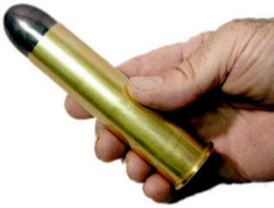

 The Accurate Reloading Forums
The Accurate Reloading Forums  THE ACCURATE RELOADING.COM FORUMS
THE ACCURATE RELOADING.COM FORUMS  Rifles
Rifles  Wildcats And Their Development
Wildcats And Their Development  What is the capacity of this case?
What is the capacity of this case?Go  | New  | Find  | Notify  | Tools  | Reply  |  |
| One of Us |
does anyone have a program that can easily calculate the capacity of this case below; base dia. .411 shld dia. .360 shld length 1.68 case length 2.28 calibre .244 neck length .296 shld angle 8 1/2 deg. | ||
|
| One of Us |
41 gr. I used the thickness of .308 brass so your capacity might be different depending on the thickness of the brass used. Whats up with that shoulder angle? | |||
|
| One of Us |
Hello Bigfoot, Thanks for the calculation. The dimensions I gave you are of the .300H&H reduced by 20% allover. I rounded afew numbers off a little, but only by a thou or two. So that 8 1/2 deg. may be ever so slightly out. | |||
|
| one of us |
I wrote up a basic case capacity calculator a while back. It's here, and it requires no download, the math being handled by the browser. The analysis isn't so complete as that offered by Big-foot, but it gets you in the ball park. I entered your numbers and assumed a case weight of 155 gn, a bit heavier than the .30-30's I've weighed. It came up with a bit under 41 gn. By the way, if you cube your 80% scaling and multiply by the case volume of the .300 H&H, you have 86 * 0.80^3 = 44.0 gn. Now, the brass walls don't scale so thin, so take a bit off the case capacity and you're back near 41 gn. If you know the weight of .300 brass, you can roughly scale it down using the ratio 0.80^2 and improve your estimate. That's 80% for the reduced girth and another 80% for the reduced length, and the same ratio for the reduced area of the base. I don't have the case weight of the .300, but I know RWS 9.3x74R brass is about 220 gn. This case is the correct length, but the diameter is about 9% (and thus the girth) too small. Applying this to the 9.3 case, I get 240 gn, and call it 250 gn to compensate for the bigger area of the base. Apply the 0.80^2 factor to this 250 gn and you get 160 gn, in line with the 155 gn rough estimate of above. The first estimate, using 0.80^3, would have made the brass too thin, at about 250 * 0.80^3 = 128 gn. The correction is 160-128 or 32 gn. Each 8.5 gn of brass displaces 1.0 gn of water, so the estimate of 44.0 gn water become 44.0 - 32/8.5 = 40.3 gn. Anyway, all this math isn't to show you I can use a calculator, but instead to show that fair estimates can be made with simple tools. | |||
|
| Powered by Social Strata |
| Please Wait. Your request is being processed... |
|
 The Accurate Reloading Forums
The Accurate Reloading Forums  THE ACCURATE RELOADING.COM FORUMS
THE ACCURATE RELOADING.COM FORUMS  Rifles
Rifles  Wildcats And Their Development
Wildcats And Their Development  What is the capacity of this case?
What is the capacity of this case?

Visit our on-line store for AR Memorabilia

